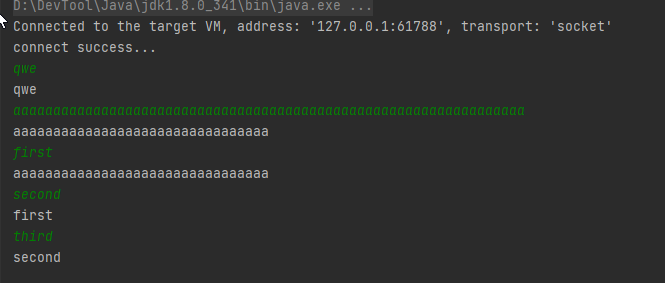BIO
wenking 7/28/2023 网络编程
# socket阻塞模型
服务端代码
@Slf4j
public class BlockServer {
public static void main(String[] args) throws IOException {
ServerSocket serverSocket = new ServerSocket();
serverSocket.bind(new InetSocketAddress(8087));
while (true) {
Socket socket = serverSocket.accept();
new Thread(() -> {
try (InputStream is = socket.getInputStream();
OutputStream os = socket.getOutputStream();) {
os.write("connect success...".getBytes(StandardCharsets.UTF_8));
while (true) {
// 接收缓存大小, 存在问题: 如果接收的数据量超过32字节,后面的字节将在下次进行读取,而此时由于客户端阻塞,
// 导致需要客户端发送下一次数据,客户端才会进行读取socket,导致效果是数据需要下次才能获取到
byte[] buf = new byte[32];
int n = 0;
try {
n = is.read(buf);
if (n > 0) {
String s = new String(buf);
System.out.println(s);
os.write(s.getBytes(StandardCharsets.UTF_8));
} else if (n == -1) {
socket.close();
break;
}
} catch (IOException ie) {
// 连接异常关闭处理
String message = ie.getMessage();
System.out.println(message);
break;
}
}
} catch (IOException e) {
e.printStackTrace();
}
}).start();
}
}
}
1
2
3
4
5
6
7
8
9
10
11
12
13
14
15
16
17
18
19
20
21
22
23
24
25
26
27
28
29
30
31
32
33
34
35
36
37
38
39
40
41
42
43
44
45
46
47
48
2
3
4
5
6
7
8
9
10
11
12
13
14
15
16
17
18
19
20
21
22
23
24
25
26
27
28
29
30
31
32
33
34
35
36
37
38
39
40
41
42
43
44
45
46
47
48
客户端代码
@Slf4j
public class BlockClient {
public static void main(String[] args) throws IOException {
Socket socket = new Socket();
socket.connect(new InetSocketAddress(8087));
InputStream is = socket.getInputStream();
OutputStream os = socket.getOutputStream();
byte[] buf = new byte[32];
int read = is.read(buf);
System.out.println(new String(buf));
while (true) {
buf = new byte[32];
Scanner scanner = new Scanner(System.in);
String s = scanner.nextLine();
// 如果读取的数据为0, 是不会发送数据的
if (s.equals("")) {
continue;
}
os.write(s.getBytes(StandardCharsets.UTF_8));
int num = is.read(buf);
System.out.println(new String(buf));
}
}
}
1
2
3
4
5
6
7
8
9
10
11
12
13
14
15
16
17
18
19
20
21
22
23
24
25
26
2
3
4
5
6
7
8
9
10
11
12
13
14
15
16
17
18
19
20
21
22
23
24
25
26
上述面程序是一个最基本的用BIO实现ECHO功能的例子,但该例子存在如下几个问题:
- 接收缓冲大小的问题: 正常情况如果客户端发送的字节不超过32个字节没有问题,但当字节超过32个,服务器缓冲一次最多只能处理32字节,因此服务端ECHO只包括最前面的32个字节, 后面返回字节需要服务端读取下次客户端输入后才会返回,每次返回也是32个字节,因此客户端数据返回进行了脱节,每次收到的数据是之前ECHO返回的数据,这些 数据其实是缓冲在接收缓冲区的。


服务端正常收数据没有问题,但客户端发送 second,收到的数据却是 first
- 该程序存在非常多的限制,读的时候阻塞,不能写,写的时候阻塞,不能读;客户端和服务端程序交互性比较差,除非改为读写分2个线程进行。
- Server数据不能一次全部读取,然后ECHO返回,当最后一次读取ECHO然后组装为String,如果长度刚好的数组长度,则需要进行下一次读,此时会阻塞线程,倒是ECHO数据返回不了, 同时客户端阻塞等待Server返回数据,导致出现活锁(读写阻塞的线程在Java中表现为RUNNABLE状态)
# channel阻塞模型
服务端代码
@Slf4j
public class BlockServer {
public static void main(String[] args) throws IOException {
ServerSocketChannel ssc = ServerSocketChannel.open();
ssc.bind(new InetSocketAddress(8087));
while (true) {
SocketChannel sc = ssc.accept();
new Thread(() -> {
ByteBuffer bf = ByteBuffer.allocate(1024);
while (true) {
try {
int count = sc.read(bf);
if (count == -1) {
//正常连接关闭处理
sc.close();
break;
} else if (count > 0) {
// 读处理
bf.flip();
log.info(StandardCharsets.UTF_8.decode(bf).toString());
bf.clear();
}
} catch (IOException e) {
// 异常关闭处理
String message = e.getMessage();
log.info(message);
try {
sc.close();
} catch (IOException ie) {
ie.printStackTrace();
}
break;
}
}
}).start();
}
}
}
1
2
3
4
5
6
7
8
9
10
11
12
13
14
15
16
17
18
19
20
21
22
23
24
25
26
27
28
29
30
31
32
33
34
35
36
37
38
39
2
3
4
5
6
7
8
9
10
11
12
13
14
15
16
17
18
19
20
21
22
23
24
25
26
27
28
29
30
31
32
33
34
35
36
37
38
39
客户端代码
@Slf4j
public class BlockClient {
public static void main(String[] args) throws IOException {
SocketChannel sc = SocketChannel.open();
sc.connect(new InetSocketAddress(8087));
sc.write(StandardCharsets.UTF_8.encode("hello, world!"));
sc.close();
}
}
1
2
3
4
5
6
7
8
9
10
2
3
4
5
6
7
8
9
10
channelBIO模型不是重点,但是也是一种新思路,供参考,其同样具有socketBIO模型的问题。
